Introduction
Managed grazing for soil health
One of the leading benefits of well-managed livestock grazing is its contribution to soil health in both annual cropping systems and perennial pastures. While soil health may be defined differently by each farmer, it is commonly agreed that well-managed grazing is good for soil. It is often included as one of the principles of soil health. A growing body of science is bringing to light that well-managed grazing can restore soil health and ecosystem function unlike any other soil health practice or style of livestock management.
What are the main principles of soil health?
Maintain continuous living cover on the land.
Maintain continuous living roots in the soil.
Minimize soil disturbance.
Maximize diversity of plants.
Integrate livestock.
Why consider grazing livestock on annual crop acres?
Cover crops and annual forages provide the perfect opportunity for the synergistic integration of crops and livestock, reducing feed and fertility costs while providing the positive impact of forage crops and livestock grazing on soil health. Cooperating with neighbors is a good way for crop farmers to gain some of these benefits without owning livestock. It can start as simply as grazing crop residues and progress on to grazing cover crops and incorporating annual forages into other windows in the crop rotation.
Cover crops and annual forage grazing contracts can provide opportunities for crop farmers to diversify crop rotations and create an additional source of revenue while gaining the positive impact of livestock on the land. Farmers who already plant cover crops in their cropping systems have much to gain by incorporating grazing onto those acres. Fencing can be a significant barrier to getting started, but there are good options for low-cost temporary fencing or even virtual fencing systems that can be considered. See the Resources section for materials on contract grazing and grazing infrastructure.
Who can benefit from grazing cover crops and annual forages?
Livestock operations currently grazing:
Diversify the forage base, boost unproductive pasture acres, give perennial pastures a rest, and develop a forage chain.
Livestock operations not currently grazing:
Reduce feed costs with a few acres of grazing.
Crop operations with no livestock:
Turn crop residues or cover crops into revenue.
Crop operations with soil health goals:
Achieve the soil health principle of livestock integration.
Where do cover crops and annual forages fit in a perennial pasture system?
Annual forages can be useful when renovation of a perennial pasture is needed, such as following outwintering, winterkill, or when a pasture is thinning or weedy. The rapid growth of annual forages can help fill gaps in pasture availability by providing short-term pasturage when a planned or unplanned renovation is needed. Using annual forages can buy time to prepare the seed bed and help smother weeds in pastures damaged by overgrazing, pugging, or outwintering.
Partnering with a neighboring farmer to plant and graze annual forages or cover crops on their crop fields can be an effective strategy to give perennial pastures on the home farm a rest during the summer slump and during other seasons when perennial cool season pasture growth is inadequate.
Building a Forage Chain with Cover Crops and Annual Forages
A forage chain is a strategy for utilizing diverse types of annual and perennial forages to ensure sufficient quantities of high-quality feed for grazing for as much of the year as possible. Producers who have the capacity to integrate annual forages and cover crops into their crop rotation or have access to other crop ground can build a grazing calendar that maximizes the use and value of low-cost grazing as a feed source. Every day that livestock can be grazed as opposed to feeding stored feed can save up to 2/3 of feed costs on a per head per day basis.
Developing a forage chain allows you to identify gaps when perennial cool season pastures are likely to be inadequate to feed the herd. Those times tend to be during the summer slump – the hot, often drier months when cool season grasses are least productive, and the shoulder seasons – the earliest and latest parts of the growing season when forage availability is challenged by weather and field conditions. Other opportunities for using annual forages include during renovation of perennial pastures, especially after outwintering, as well as moving animals onto annual forages planted on cropland in late summer and fall to allow stockpiling of perennial pastures for late fall grazing. Ensuring continuous availability of grazable forages for as many months as possible can be a financially sound strategy for grazing operations.
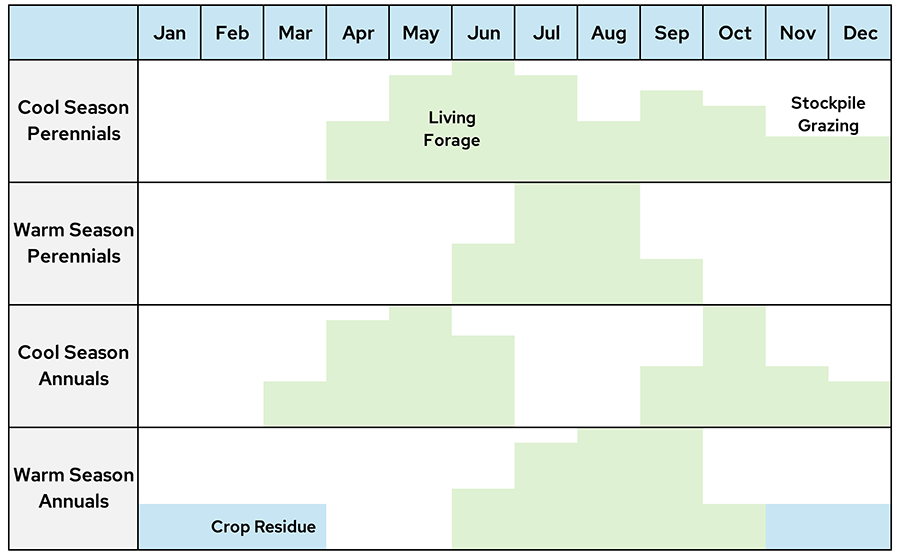
Whether you’re a livestock producer seeking to extend the grazing season with annual forages or you’re a grain farmer seeking to incorporate cover crop grazing into your system, understanding the seasonality, growth characteristics, and agronomics of the wide array of cover crop species is the first step. This publication will walk the reader through that process and lay out timelines for planting to ensure the forage is available at the right time.
Well-managed grazing: what is it?
The key to maximizing the soil health benefits of integrating livestock is how the grazing is managed. Well-managed grazing provides a positive impact because it focuses on the long-term health of the land (soil, plants, water) simultaneous to the that of the livestock. The differentiating feature is that managed grazing involves concentrating the herd in subsections of the pasture (paddocks) and employs these three principles:
Rotation – move herd (every 1 -3 days).
Residual – leave behind a minimum 4” of stubble.
Rest – allow forage to regrow for at least 30 days.
While these principles most directly apply to a perennial forage system, they should also be practiced for annual forages and cover crops to preserve the positive impacts they have on the land and crop yields.
Cover Crop Grazing Basics
Selecting species for grazing – There are many benefits to planting multi-species blends of cover crops, especially when planning to graze them. Planting a mix of species usually improves forage yield and quality. Using well-managed rotational grazing for this purpose often allows multiple grazing events and will maximize both the productivity and soil health benefits of grazing cover crops and annual forages. The cover crop species options can be grouped into categories based on plant families and seasonal growth curves. But what should go into your species mix? To match your forage needs, characteristics to consider include primary growth season, forage quantity potential, forage quality potential, and winterhardiness, including standability through snow. Matching appropriate annual forage species with times when pasture is short is the first step in ensuring sufficient quantities of forage will be available when needed.
Palatability and anti-quality factors – The annual forages and cover crops discussed in this publication are all known for their forage quality characteristics, and while all are palatable, there may be some initial refusal when introducing a herd or flock to a new forage source for the first time. This can be dealt with by introducing the new species for a few hours a day until it is readily consumed. Ensuring sufficient roughage in the diet can smooth the transition from one forage source to another. Including a grass in the mix, and/or feeding some supplemental hay or balage can help with this. In addition, there are a few anti-quality factors in these forages to be aware of, including nitrate accumulation in grasses and brassicas, prussic acid in sorghum and sorghum crosses, bloat in legumes, and high water/low dry matter content in brassicas. These issues will be discussed in more detail under the species section. In general, when species are used in an appropriately balanced mix, these challenges can easily be overcome.
Planting and fertility – Most cover crop species can be drilled using a no-till or conventional drill or broadcasted, including aerial application, following removal of the previous crop. Cover crop mixes can be designed for seeding into a standing annual grain crop for later season growth after the main season grain crop is harvested. If phosphorus, potassium and soil pH are managed to be adequate for the main season crop, they are likely to be sufficient for healthy subsequent cover crop growth. Verifying this with routine soil tests at least every four years is recommended. An application of nitrogen fertilizer may be warranted to increase forage yield for cover crop grazing. Manure application can be the best option to supply nutrients, but manure should be either incorporated or applied far enough in advance that it doesn’t interfere with palatability of the cover crop to be grazed.
Categories of Cover Crop and Annual Forage Species
Cover crop species can be grouped into four main categories: brassicas, grasses, legumes, and other annual broadleafs. General principles for creating a cover crop mix for grazing include 1) choosing species from each of the three functional groups (grasses, broadleafs, and legumes), 2) including 4 to 6 species in the mix, and 3) selecting species that are compatible with each other and adapted for the season when you need the forage. See the table on page 13 for seeding rates and other planting information.
Grasses should be a mainstay of most cover crop mixes for grazing, providing structure, significant high-quality tonnage, and a consistent supply of roughage for rumen health. They can be planted anytime during the growing season, including early-spring or late-summer seedings. They will provide abundant above-ground biomass and can be rotationally grazed multiple times throughout the season. The amount of regrowth will vary by season and depend on weather and soil moisture conditions.
Grass species can be further divided into three groups: cereal grains, warm season annual grasses, and cool season annual grasses. Under certain conditions, nitrate accumulation can be a concern in young cover crop stands. Annual grass species, both winter annual and summer annual, as well as brassicas, may accumulate excess nitrate under certain conditions. While nitrate poisoning of livestock is rare, it can occur when grazing forage that was dormant for a prolonged period of drought and resumed rapid growth after receiving substantial rainfall. Suspected high nitrate conditions can be verified with nitrate sampling of forage tissue provided by commercial laboratories.
Cereal grains can be grouped into two categories: spring and winter. Spring grains include oats, spring barley, and spring wheat. Winter small grains, normally planted in late summer and harvested the following summer, include winter wheat, rye, barley, and triticale. Because we’re not concerned with grain production, we can often use these species in seasons when we wouldn’t normally grow them, such as planting forage oats in late summer for fall grazing.
Sometimes forage production and grain production can both be accommodated. For example, winter wheat or rye can be grazed in spring and then the crop can be allowed to mature and produce grain in summer. Winter small grains will not produce significant biomass for grazing in fall but can be used for early spring grazing allowing cool season perennial pastures ample growth before grazing. Cereal grains are a mainstay of most cover crop mixes and contribute significantly to forage yield and quality.
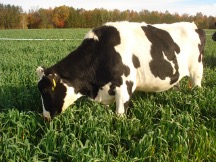
Warm season annual grasses include millets, sorghums, sudangrass, sorghum-sudangrass crosses, and even corn. These grasses thrive in hot dry conditions in late summer as long as sufficient moisture is available for germination. They produce significant tonnage of moderate quality forage (high digestible fiber, moderate protein) and can be grazed multiple times in late summer through late fall. The amount of regrowth following grazing will vary depending on weather and soil moisture conditions. These species winterkill early but can be grazed into early winter after frost has killed the plant. Nitrate and prussic acid are concerns with plants in the sorghum family. Prussic acid is relatively high when plants are less than 20 inches tall. Waiting until plants are more than 6 weeks old and at least 20 inches tall reduces the risk of prussic acid poisoning. Prussic acid is also more prevalent in the plant after a hard frost regardless of plant height. Poisoning can be avoided by waiting for a period of 10-14 days to graze the forage, or by planting annual forages that do not accumulate prussic acid, such as millet.
Cool season annual grasses currently include only one species: annual or Italian ryegrass, a valuable mainstay of cover crop mixes for grazing. Annual ryegrass is a fast-germinating, high quality forage species that can be grazed multiple times throughout the growing season. It is cold tolerant and despite its name, can sometimes overwinter. Legumes can be further divided into perennials, such as red or white clover, annuals commonly used for fall and winter mixes such as berseem or crimson clover, and annuals used in summer mixes like forage peas. Hairy vetch is considered annual or biennial as it does sometimes overwinter. Legumes are mainly cool season crops that can be planted in cover crop mixes at any time of the year. Cowpea and sunn hemp, both annuals, are species that areespecially tolerant of hot dry weather. Legumes are easy to establish and complement grasses and brassicas well. They are most frequently recommended as a component of a mix as opposed to a pure seeding. Legumes can produce significant tonnage of high protein forage and they also fix atmospheric nitrogen that can help with fertility for other species in the mix or the following crop.
Bloat can be a concern when grazing legumes in a cover crop mix. Clovers tend to have high concentrations of crude protein, and as a result are prone to causing bloat. Conditions for bloat are most common when clover is immature and under rapid growth. This can be avoided by grazing clovers that are mature and by rotating livestock onto fresh forage late in the day when moisture content is lowest. Ensuring a balanced species mix with high proportions of grasses can help minimize bloat problems.
Perennial legumes, while more winter-hardy than annuals, are often considered in cover crop and annual forage mixes because they are a readily available and cost-effective way to integrate a legume component into the mix. Perennial legumes are slower to establish and will not provide quick above-ground biomass for grazing. They also require careful consideration for termination when rotating to the next crop the following season. Red clover is the most common perennial legume species used in cover crop and annual forage mixes. Annual legumes include berseem clover, crimson clover, cowpeas, hairy vetch and winter peas. Annual legumes can usually provide at least 0.5 tons DM/acre of available forage in fall if planted in August or earlier, but if planted in September or later the above-ground biomass may be inadequate for grazing. There is often a distinction made between winter and summer annual legumes, but most species don’t consistently fit within those bounds. Winter hardiness is highly dependent on winter conditions, region, and variety. Most will regrow after grazing with adequate moisture and temperature.
Brassicas are broadleaf plants in the broccoli plant family, including radish, rape, sugar beets, turnips, and kale. These cool season species are usually planted in summer for fall and early winter grazing but can be planted earlier in the season when grazing is planned. They produce a quick ground cover of abundant leaves that are very high in forage quality, especially protein, but relatively low in dry matter yield due to high moisture content. Multiple grazing events are possible, but the amount of regrowth will be less each rotation and will depend on weather and soil moisture conditions. They will winterkill. Some, such as oilseed radish, sugar beet, and turnip produce a bulb or taproot that is fleshy and edible. Oilseed radish is often touted as combating soil compaction with its thick, long taproot. Collard is one of the most heat tolerant brassicas. Brassicas germinate quickly and are very competitive in a mix. A very low seeding rate in mixes will result in a better balance of species.
Anti-quality factors include possible high nitrate levels mentioned above under grasses, and high water content. Due to the high water content of brassicas (up to 95-98% of their total contents), livestock grazing brassicas are consuming primarily water, and possibly not achieving adequate daily dry matter intake required to ensure good rumen health. Despite the high digestibility of brassicas, livestock can lose body condition on lush forage. Bloat is also a possible risk. These all can be avoided by mixing brassicas with other species that are higher in dry matter or supplementing with hay.
Other broadleaf annuals include buckwheat, sunflower, winter camelina, flax and a few other species. The primary species that are often used in cover crop mixes in the upper Midwest are buckwheat and sunflower. Both are warm season species that are unlikely to provide significant tonnage or improve forage quality in a grazing mix. They can be included at low seeding rates to contribute to species diversity and pollinator habitat value. Winter camelina is a winter annual, planted in late summer and overwintering to produce seed in spring. It is being used in cover crop mixes as a nitrogen scavenger but is unlikely to contribute significantly to forage yield.
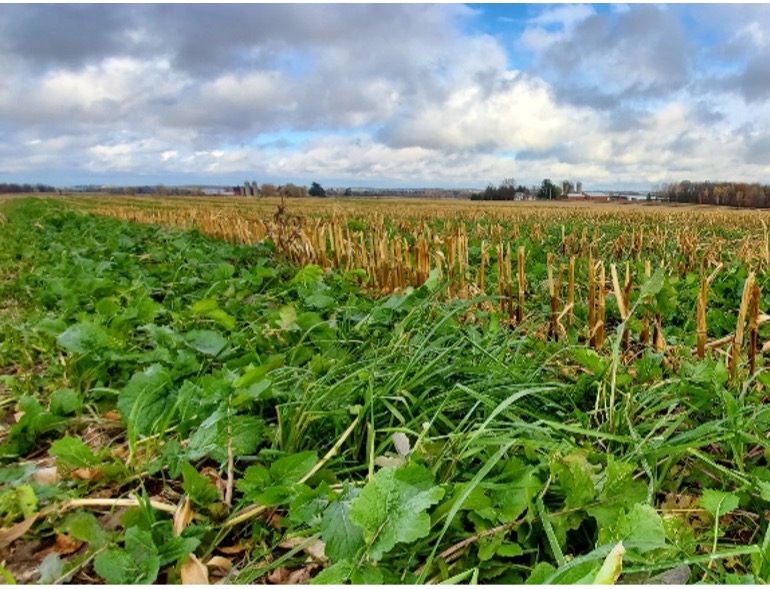
Seasonal Options for Grazing Cover Crops and Annual Forages
The forage chain identifies when forage supply will be short, allowing the farmer to develop strategies for filling the gaps. In this section, windows of opportunity for annual forage production will be identified and options will be laid out for planting times and seeding mixes to ensure forages are available for those windows. These include: Late fall through early spring, spring through early summer, midsummer through early fall, and late summer through late fall.
The key to success with cover crop grazing is giving the planting enough time to establish and accumulate sufficient biomass for grazing. This may require modifying crop rotations or using shorter-season grain varieties to allow a long-enough window for cover crop establishment and growth. Timing is critical, and weather may not always cooperate. Cover crops must be seeded into a standing grain crop or during a narrow window following harvest and must have adequate moisture to germinate to allow adequate time for forage to accumulate. Integrating cover crops into annual grain (e.g., corn-soybean) and forage production (e.g., corn silage-alfalfa-small grain) systems can be challenging, but can reap significant benefits to cropping systems. The following are some windows of opportunity to get cover crops established based on the time of year when forage is needed.
Late fall through early spring grazing

Extending the grazing season into late winter through early spring can reduce the cost of winter stored feeds and the accompanying labor. This period involves primarily grazing dead or dormant forages and grazing times will be highly weather dependent.
Seeding can occur mid-summer to late fall depending on the species and grazing window desired. Options include planting after or into winter wheat, soybeans or corn silage. Winter small grains and perennial legumes survive the winter and can be included in the mix if the following season’s cropping plans accommodate them. They must be planted early to accumulate enough tonnage for late fall or winter grazing. Warm season annual grasses, summer small grains, annual legumes, brassicas and other annuals like sunflower, will all winterkill but can continue to be grazed unless snow and ice impede access to the forage.
Forage quality declines significantly after plant death, but this source of roughage may be supplemented with high quality feeds if necessary. Care must be taken to avoid damaging saturated soils when grazing during winter and spring.
Approach: Diversify the crop rotation to accommodate planting of cover crops
Adding winter small grains to a corn-soybean rotation creates a window in August every three years or on a third of the acreage to seed a cover crop for fall grazing. Substituting a summer annual forage for the main season crop can provide that same window in late summer for seeding cover crops for fall grazing. Oftentimes, these acres also serve as a place to receive late-summer manure applications, creating a low-risk window to empty the manure storage and providing fertility for the following cover crop. This option provides the greatest window of opportunity for establishment as well as the fullest array of options for species. Cover crops planted during August into early September can include species from any of the functional groups.
Suggested mix:
- Oats
- Winter rye
- Winter peas
- Crimson clover
Spring through early summer grazing

Annual forages for early growing season grazing in April and May can be planted on crop ground after a winter wheat harvest or for early grazing before a soybean planting, especially if using a short-season variety (see below). Planting time is late summer to late fall. For most species, drilling or broadcasting will work as a seeding method. This overwintered seeding is the most limited in terms of species composition and should always include a winter grain as the main component. The earlier it can be planted in late summer, the more tonnage you can expect the following spring.
Approach: Select grain maturities that accommodate planting of cover crops
Selecting corn or soybean maturities that are on the lower end of the scale for the region can provide a greater window of opportunity for establishing cover crops after harvest. A short-season corn or soybean variety planted in southern Wisconsin can provide an extra three weeks of growing time for a subsequent cover crop, although it may result in lower yields of your main crop. Even with added weeks for growth, the species options for this use are largely limited to winter small grains and perennial legumes.
It must be noted that some legumes such as hairy vetch can contain a large percentage of hard seed that can germinate a year or more later and become a “weed” in subsequent row crops. Planting of winter small grains and perennial legumes can occur through the month of October and early November to provide grazing in spring.
Winter small grains green-up early and grow rapidly, so grazing can begin as soon as the forage reaches 6 inches tall and the soil is fit to withstand hoof traffic. If lightly grazed, the crop can be allowed to mature and harvested for grain.
Suggested mix:
Midsummer through early fall grazing

Annual forages can fill the gap during the summer slump or after a winterkilled alfalfa crop, provide insurance against drought, or give perennial pastures a longer rest period. There may be crop insurance implications that should be considered before grazing these, but otherwise grazing periods include June through the end of the growing season. Planting into a terminated alfalfa field or after any annual grain crop are good options. Planting time is spring and early summer. Seeds can be drilled, broadcast, or interseeded into a standing grain crop for later growth after the grain is harvested.
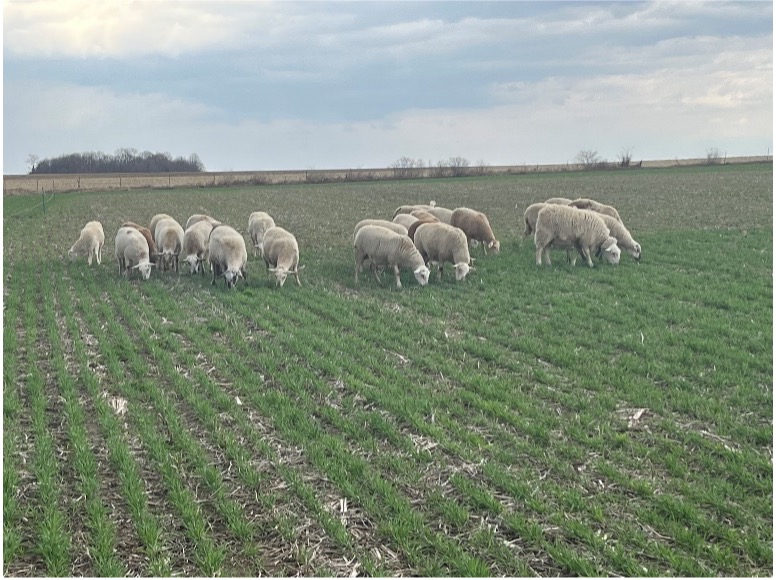
Because this planting time is at the height of the growing season, we have the largest number and widest range of potential species to work with. Appropriate species include any of the brassicas, any of the spring cereal grains, annual ryegrass, any of the warm season annual grasses, any of the legumes, and other species like sunflowers or buckwheat. Most mixes should include one or more of the grasses to provide tonnage and structure. Frost-sensitive legumes such as annual clovers and peas can be added to provide protein. Brassicas at a low seeding rate will contribute to forage quality and tonnage. Radish can be added if compaction is a concern. Most species other than winter small grains can be considered.
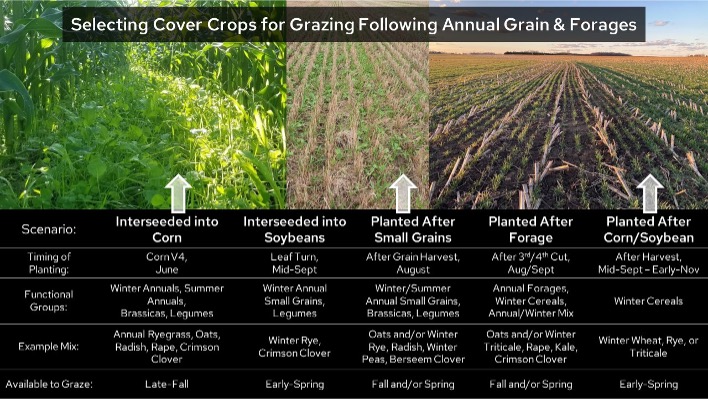
Approach: Rotate hay acres in spring or late summer to establish a cover crop
Aged stands of alfalfa or grass/legume mixes that are due to be rotated the next spring can be terminated after any cutting and planted to a cover crop mix for summer, fall, and winter grazing. This may not always be worth the cost compared to simply grazing the established forage, but in many cases a newly established cover crop will provide more dry matter than an aged hay stand, especially if coupled with a manure application.
Suggested mix:
Late summer through mid-fall grazing

Annual forages are a good choice for addressing the summer slump in perennial pastures in July and August or extending the grazing season into September and October. Making annuals available for late summer grazing can give the producer the opportunity to set aside perennial pastures for stockpile grazing after the growing season has ended. Or an annual mix can be planted to be that stockpile grazing opportunity, adding a potential 30 to 60 days of grazing into the fall. Planting should occur no later than mid- to late-summer into harvested winter wheat, terminated alfalfa, outwintered pasture, or the mix can be interseeded into an annual grain crop for post-harvest growth.
Mixes for this window are similar to those for mid-summer grazing above. We have wide variety of potential species to work with. Appropriate species include any of the brassicas, any of the spring cereal grains, annual ryegrass, any of the warm season annual grasses, any of the legumes, and other species like sunflowers or buckwheat. Most mixes should include one or more of the grasses to provide tonnage and structure. Some of the warm season species such as millets and sorghums are frost sensitive, but may be grazed after frost has killed the plants (see prussic acid recommendations above). Spring cereal grains planted in mid-summer are especially good for this window of opportunity. Several varieties of oats were bred especially for this use. Frost-sensitive legumes such as annual clovers and peas can be added to provide nitrogen. Brassicas at a low seeding rate will contribute to forage quality and tonnage. Radish can be added if compaction is a concern. Most species other than winter small grains can be considered.
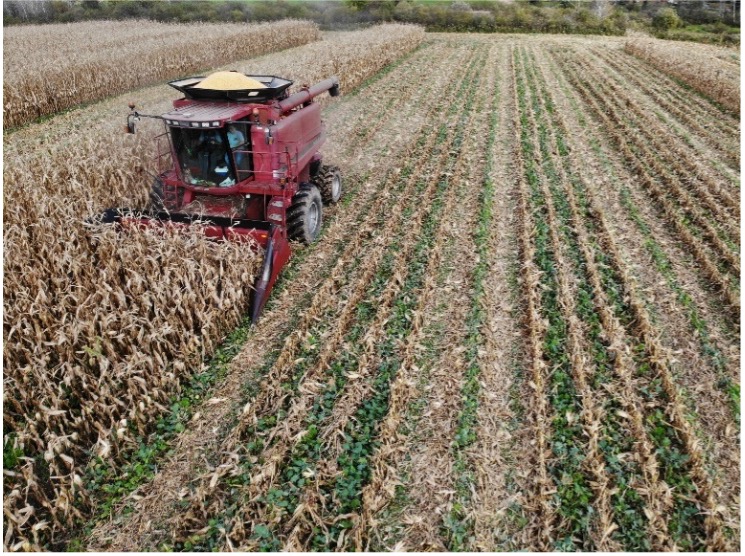
Approach: Interseed cover crops into grain crops
A way to work around the physiological and logistical challenges of getting cover crops established is to interseed cover crops into growing grain crops early in the growing season. This practice has shown the best success in establishing a strong cover crop stand that provides enough tonnage to be grazed. For that reason, the options for this practice will be described in detail below. Cover crop seed can be broadcast, aerially seeded, or interseeded with a modified drill. The interseeded cover crop plants germinate and grow slowly beneath the canopy of the main crop until it is harvested. After grain crop harvest, the cover crop plants grow quickly with shade and competition removed and are ready to graze in late fall. Nearly every functional group and species of cover crop can be utilized for interseeding, depending on the seeding method and the time of planting. The table in Figure 7 describes the considerations.
Suggested mix:
The logistics of interseeding cover crops into grain crops
For the practice of interseeding cover crops to be successful, attention to detail is required. The timing of planting, planting method, and species selection all must be conducive to each other and to the end goal of grazing cover crops. Some considerations for each of those include:
Timing of Planting
To ensure that cover crops do not negatively impact corn yield, they can be interseeded into standing corn at two times – between the V2 and V4 growth stages, or after 50% milkline when the corn is nearing maturity. The exposure of sunlight to the soil surface between rows is critical to the success of interseeding. While interseedings after V4 can be successful, there is greater risk involved as the corn rows are quickly progressing toward full canopy enclosure. Some farmers are experimenting with 60” wide corn rows to ensure adequate light exposure for cover crop growth. In soybeans, interseeding should occur when plants near maturity and begin to senesce, which is signified by leaves turning color and dropping, allowing sunlight to penetrate to the ground between rows. Ideally, interseeding should occur in soybeans during the short window between leaves turning color and dropping to ensure greater seed-to-soil contact. When planning for interseeding of soybeans with ground driven equipment, it is advisable to plant soybeans in rows to avoid damaging the crop with application equipment, although interseeding into drilled soybeans can happen without crop damage when following wheel tracks from previous fertilizer or herbicide applications, or using aerial seeding.
Shade tolerance
Species’ abilities to tolerate extended periods of shade between corn or soybean rows is also an important consideration. Winter annual grasses tend to not tolerate shade as well as summer annual grasses, so there is risk involved with interseeding them. Most brassicas and legumes work well with either planting method and can tolerate shade well. Clovers, annual ryegrass, and oats work exceptionally well.
Interseeding Methods
Drilling into standing corn or soybean rows requires specialized equipment and involves the risk of damaging the standing crop. However, drilling ensures the greatest degree of seed-to-soil contact, and in many cases results in quicker, more successful establishment. Most specialized interseeding equipment with drill/row units are grain drills or fertilizer sidedressing toolbars that have been modified for interseeding. This type of interseeding can only occur before the crop is too tall to pass through.
Broadcasting into a standing crop can cause crop damage if traditional pull-type fertilizer broadcasters are being used. But other types of broadcasting tools such as high-boy fertilizer applicators, aircraft (planes, helicoptors) or unmanned aerial vehicles (UAVs, drones) can help to minimize the risk of damaging the standing crop and can be done at the times recommended above.Broadcasted interseedings are most successful when denser, harder seeds like those of clovers, brassicas, or ryegrass are used because they have a better chance of making it through the air, through the plant canopy, and settling onto the soil surface. Seeding rates for broadcast seeding are higher because of the lower potential for successful establishment with this method.
Wide-row corn (60” rows) can be a way to increase the forage production of interseeded cover crops by limiting shading from corn and maximizing the amount of sun exposure between corn rows. Trials in North-Central WI indicated that corn silage planted in 60” rows yielded 36% less (5.6 tons DM/acre) than 30” rows, but that interseeded cover crops in 60” rows yielded 340% more (1.4 tons DM/acre) forage biomass than cover crops planted between 30” rows.
Using Annual Forages in Perennial Pasture Systems
Although the mainstay of grazing systems is likely to be perennial cool season pastures, annual forages can play an important role in pasture renovation following outwintering or other pasture damage.
Renovate perennial pastures with annual forages
Perennial pasture acres in need of renovation provide a prime opportunity for integrating annual forages into the grazing season. Areas that have thinned and declined in species composition and productivity can be filled in by interseeding with annual forages for a few months until a favorable time for reseeding perennial cool season pasture. Areas that have been damaged from overgrazing, pugging from grazing under wet conditions, or outwintering can be recovered with annual forages before being reseeded to a perennial mix.
For pastures that require a full renovation that includes termination or tillage see the UW-Madison Extension fact sheet Renovating Cool-Season Pastures for Improved Grazing. Even when a more aggressive renovation approach is necessary, annual forages can be a helpful tool.
Damaged or Thinning Pastures
Extremely rough or unproductive pastures or pastures that have winterkilled can be improved with the use of an annual forage mix. Rough pastures that have been damaged by equipment or grazing under wet conditions may require tillage to be smoothed back out. Likewise, unproductive pastures with undesirable forage species (or weeds) may require tillage to control existing vegetation and prepare a seedbed for reseeding. The advantage of planting annual forages versus perennials in this case is quick establishment of forage for more immediate grazing and reducing weed competition. The annual mix can be planted in spring, grazed multiple times during the growing season, and then succeeded by a fall seeding of perennials, when weed competition is lower and there’s a greater chance of successful perennial establishment.
Outwintered Pastures
Overwintered pastures can be recovered with an annual forage mix. Outwintered pastures can be more difficult to repair than those damaged during the grazing season because a layer of residual hay is left on the soil surface after winter bale feeding on pasture. Depending on the thickness of the layer, it can take up to an entire growing season to decompose. Re-establishing perennials before the hay layer is gone may result in spotty germination and inconsistent establishment. A vigorously growing annual mix can be a low-cost option for maintaining production on those acres during the first season after outwintering while residual hay decomposes and conditions become more favorable for successful establishment of perennials.
Species selection
An annual forage mix that is well suited to a full season of grazing on damaged and outwintered pastures should consist of at least one species from each of the functional groups – an annual small grain, a summer annual grass, a brassica, and a legume. Each species in this mix will thrive under different conditions at different times in the grazing season, increasing the potential for at least four grazing events, if the principles of managed grazing are applied.
Putting it all together: Selecting species, mixes, and seeding rates that work for your farm
When selecting cover crop and annual forages, it is very important to utilize species and mixes that have been proven to work in the production system, region, and soil type. There are many options available today, and not all of them are adapted to the systems described in this publication. Be sure to source seed from trusted suppliers with experience in cover crop and annual forage systems. The Midwest Cover Crops Council (MCCC) selector tools are a helpful aid in identifying species and mixes that work in your area. Additionally, the MCCC publishes the Cover Crops Field Guide which is full of species selection and management information and can be purchased on their website. Species recommendations for cover crops and annual forages from UW, USDA-NRCS and MCCC have been collated in the table on page 13 of the PDF below.
Additional Considerations for Grazing Cover Crops & Annual Forages
There are a couple other important factors that are often overlooked in cover crop and annual forage systems for grazing. They are:
Soil Fertility
Since cover crops are often used to scavenge excess nutrients at the end of the main crop growing season, and annual forages are often referred to as “alternative crops,” it is often a foregone conclusion for many farmers that nutrient applications are not needed. In some cases, there may be enough nutrients left over from the main crop, while in other cases additional nutrients are needed. While this is a decision that involves economic as well as agronomic considerations, there are many instances where an application of a nutrient source is financially justified as it results in significantly more dry matter yield for grazing. On operations with existing livestock, the best source of nutrients may be manure. In general, each ton of dry matter per acre will require about 35 lbs of nitrogen, 15 lbs of phosphorus, and 45 lbs of potassium.
Cost
For grazing of cover crop or annual crops to be successful, it cannot cost significantly more than other feeding alternatives. While the value of cover crops is greater than just their forage value (value of soil health, nutrient retention, water quality, etc.), they must also be cost-effective. A low-yielding cover crop or annual forage in most cases will be a more costly feed source than a stored-feed alternative. This is why it’s critical to select species and varieties that are proven in your system, soil type, and climate, and to avoid including species that add cost but do not add value to the forage or soil.
Herbicide Carryover
Many herbicides that are commonly used for annual grain production also have restrictions that limit the use of cover crops or crop residues in treated fields for grazing or feeding. These grazing and feeding restrictions are indicated on product labels, which farmers are legally obligated to follow. The following publications offer more guidance on herbicide considerations:
Grazing Cover Crops and Annual Forages Resources
Midwest Cover Crops Council
Green Lands Blue Waters – Perennial Forage Working Group
Midwest Grazing Exchange
Article Contributors:
Adam Abel, Grazing Specialist, USDA-Natural Resources Conservation Service
Chris Bandura, Conservation Cropping Outreach Specialist, UW-Madison Division of Extension
Derrick Raspor, Resource Conservationist, USDA-Natural Resources Conservation Service
Jamie Patton, Soil Health Coordinator, USDA-Natural Resources Conservation Service
Matt Oehmichen, Agronomist, Short Lane Ag Supply
Will Fulwider, Crops & Soils Educator, UW-Madison Division of Extension
Last Updated: July 15, 2025

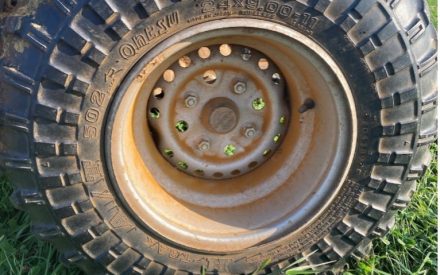 Managing Rust in Cool Season Pastures
Managing Rust in Cool Season Pastures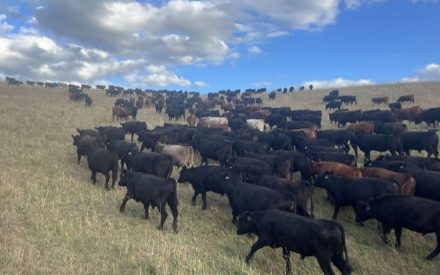 Grazing to Protect Surface Water: Considering critical and sensitive areas
Grazing to Protect Surface Water: Considering critical and sensitive areas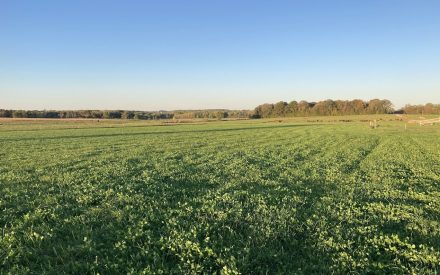 Research Brief: Interseeding legumes into grass pastures
Research Brief: Interseeding legumes into grass pastures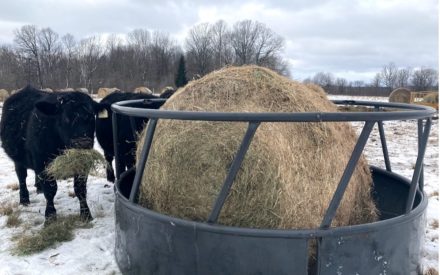 Research Brief: 2024 Wisconsin bale grazing project
Research Brief: 2024 Wisconsin bale grazing project


